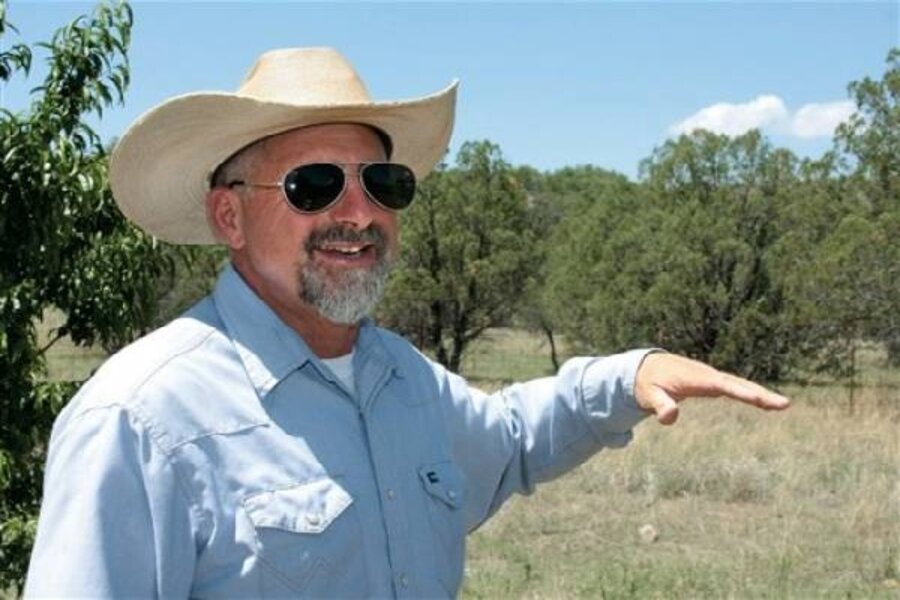Native grasses help reclaim Arizona wastelands
Loading...
| SIERRA VISTA, Ariz.
Down at the bottom of a sleepy little valley, Jim Koweek is checking over his nonproductive fruit trees. He knows just about all there is to know about grasses in this corner of Arizona that encompasses Cochise and Santa Cruz counties. Yet his apple and peach trees have yet to produce much. "We planted these 14 years ago. The peach trees were given to me by a Hopi native American that had been growing on the reservation, so I figured they would be hearty. But in 14 years, we have gotten maybe 14 pounds of peaches and apples," he said.
Fortunately, he makes his living in a trade other than fruit. He helps revegetate fields and pastures, reclaim land laid waste through development or mining, and provides erosion control. His business, Arizona Revegetation & Monitoring Co., deals exclusively with native grasses. With 25-plus years under his belt in the field, there are few circumstances he's encountered that haven't been able to yield fields of greens in summer and golds in fall if all planting conditions have been met.
"Our approach to plants and seed is pretty basic," he said. "The growing conditions here are tough. High winds, single-digit humidity, alkaline soils, drought and temperature extremes are all common. Wimpy plants can't cut it. To give your project the best chance for success over the long haul, use species native to your area."
The problem with growing anything in the high desert or on mountain slopes is the lack of moisture. Then there's the wind. It's relentless some days and gentle as a mother's blown kiss on others.
"I've found that tall and skinny does not do as well as short and round," he said. "It has to be able to withstand the wind, and tall and skinny doesn't cut it."
Walking along the road Sunday morning close to his home near Canelo, he pointed out damage from the drought of recent years. The stress from lack of water disables the immune systems of alligator juniper, black oaks and manzanita, making them unable to cope with insects or blight. The trunks and branches stand blackened as if by fire on the hillsides.
"As the trees die, that allows more sun to hit the ground. That kills off the native shade grasses like pinion rice grass," he said. "They're all taking a hit from the drought. You're seeing change in action. The plants have to adjust or die."
He's concerned with the lack of winter rain, and now the monsoon seems slow to turn the brown rivers of grass to emerald green. The wash that runs through his six acres on the back side of the Huachuca Mountains normally holds a little water by this time of year. It's bone dry. With only one way in or out, a fire down in the valley would be devastating.
How does he know what seed will grow in this area? Trial and error, he said.
"It's 100 percent the School of Hard Knocks," he jokes. "How hard can it be to work with grasses in a grassland area?"
Then he muses, "If it didn't take a lot of schooling, I could have been a scientist."
With no formal education in botany or science, he just sort of learned what worked and what doesn't. His monitoring studies have taken him to various places around the Huachucas. He sets up a 15-inch grid, watches what grows with what amount of water and notes the species that manage to make it.
He found that most ground needs some preparation. You can't just dump some seed on the ground, water it, and expect it to grow. The soil has to be "roughed up" so the seed can settle into tiny crevices and cracks to germinate.
That is a project done with care. The soil is hundreds of thousands of years old, he said.
"Someone can undo 700,000 years of geologic activity in a matter of minutes," Koweek said. "It can take many years to re-establish it and bring it back."
He generally offers a mix of six to eight seeds so that if one or two don't produce, the others will. The varieties also sprout at different times. That's important, too, since the early grass will help slow rainwater and allow it to soak in.
Sitting on his shady stone patio, he looked out over the coral honeysuckle and vivid purple echinacea and offered this advice: "If you want to plant something and keep it watered, make it something that gives back to the wildlife. The butterflies loves the echinacea and the hummingbirds love the honeysuckle."
"After I plant somewhere, I'm either a genius or a bum. If it rains good, I'm a genus. If it doesn't, I'm a bum."
Editor’s note: For more on gardening, see the Monitor’s main gardening page, which offers articles on many gardening topics. Also, our blog archive and our RSS feed. You may want to visit Gardening With the Monitor on Flickr. Take part in the discussions and get answers to your gardening questions. If you join the group (it’s free), you can upload your garden photos and enter our next contest. We’ll be looking for photographs of fruits. So find your best shots of summer’s blueberries, peaches, plums, etc., and get out your camera to take some stunning shots of early fall apples. Post them before Sept. 30, 2009, and you could be the next winner.





